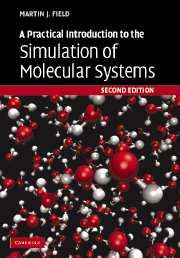Book contents
- Frontmatter
- Contents
- Preface to the first edition
- Preface to the second edition
- 1 Preliminaries
- 2 Chemical models and representations
- 3 Coordinates and coordinate manipulations
- 4 Quantum chemical models
- 5 Molecular mechanics
- 6 Hybrid potentials
- 7 Finding stationary points and reaction paths on potential energy surfaces
- 8 Normal mode analysis
- 9 Molecular dynamics simulations I
- 10 More on non-bonding interactions
- 11 Molecular dynamics simulations II
- 12 Monte Carlo simulations
- Appendix 1 The pDynamo library
- Appendix 2 Mathematical appendix
- Appendix 3 Solvent boxes and solvated molecules
- Bibliography
- Author index
- Subject index
1 - Preliminaries
Published online by Cambridge University Press: 03 December 2009
- Frontmatter
- Contents
- Preface to the first edition
- Preface to the second edition
- 1 Preliminaries
- 2 Chemical models and representations
- 3 Coordinates and coordinate manipulations
- 4 Quantum chemical models
- 5 Molecular mechanics
- 6 Hybrid potentials
- 7 Finding stationary points and reaction paths on potential energy surfaces
- 8 Normal mode analysis
- 9 Molecular dynamics simulations I
- 10 More on non-bonding interactions
- 11 Molecular dynamics simulations II
- 12 Monte Carlo simulations
- Appendix 1 The pDynamo library
- Appendix 2 Mathematical appendix
- Appendix 3 Solvent boxes and solvated molecules
- Bibliography
- Author index
- Subject index
Summary
Introduction
The aim of this book is to give a practical introduction to performing simulations of molecular systems. This is accomplished by summarizing the theory underlying the various types of simulation method and providing a programming library, called pDynamo, which can be used to perform the calculations that are described. The style of the book is pragmatic. Each chapter, in general, contains some theory about related simulation topics together with descriptions of example programs that illustrate their use. Suggestions for further work (or exercises) are listed at the end.
By the end of the book, readers should have a good idea of how to simulate molecular systems as well as some of the difficulties that are involved. The pDynamo library should also be a reasonably convenient starting point for those wanting to write programs to study the systems they are interested in. The fact that users have to write their own programs to do their simulations has advantages and disadvantages. The major advantage is flexibility. Many molecular modeling programs come with interfaces that supply only a limited range of options. In contrast, the simulation algorithms in pDynamo can be combined arbitrarily and much of the data generated by the program is available for analysis. The drawback is that the programs have to be written – a task that many readers may not be familiar with or have little inclination to do themselves. However, those who fall into the latter category are urged to read on. pDynamo has been designed to be easy to use and should be accessible to everyone even if they have only a minimum amount of computing experience.
- Type
- Chapter
- Information
- Publisher: Cambridge University PressPrint publication year: 2007

